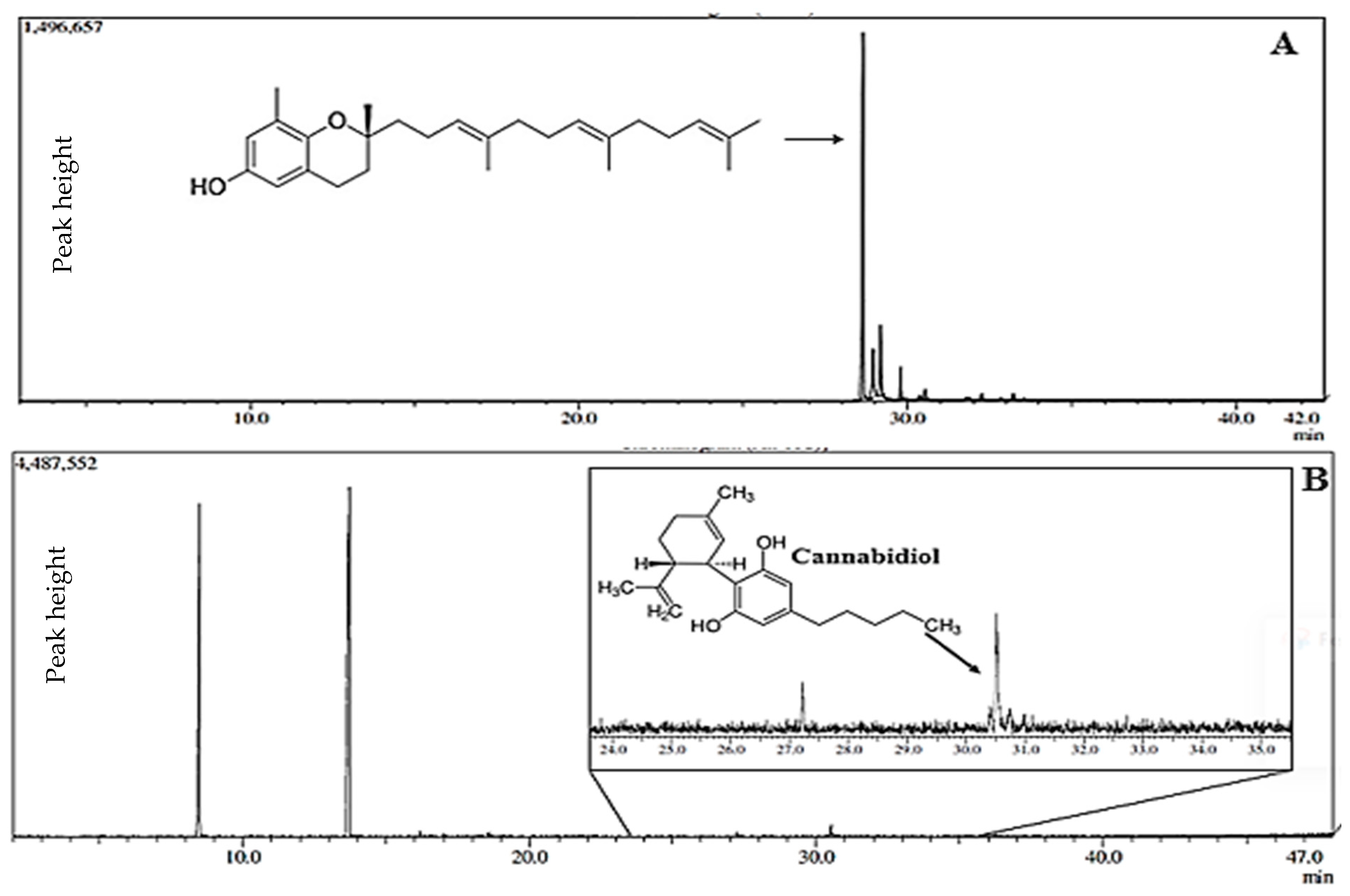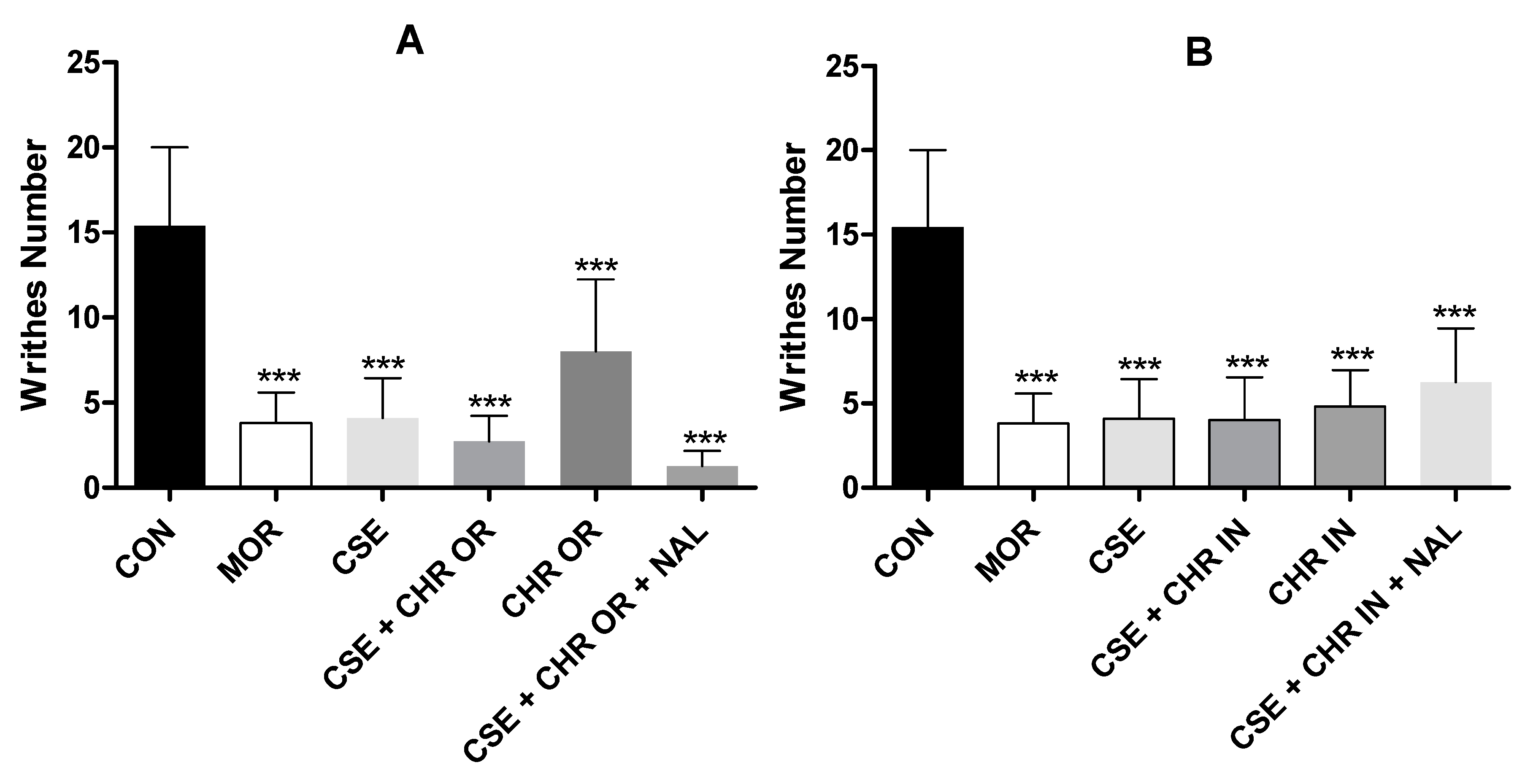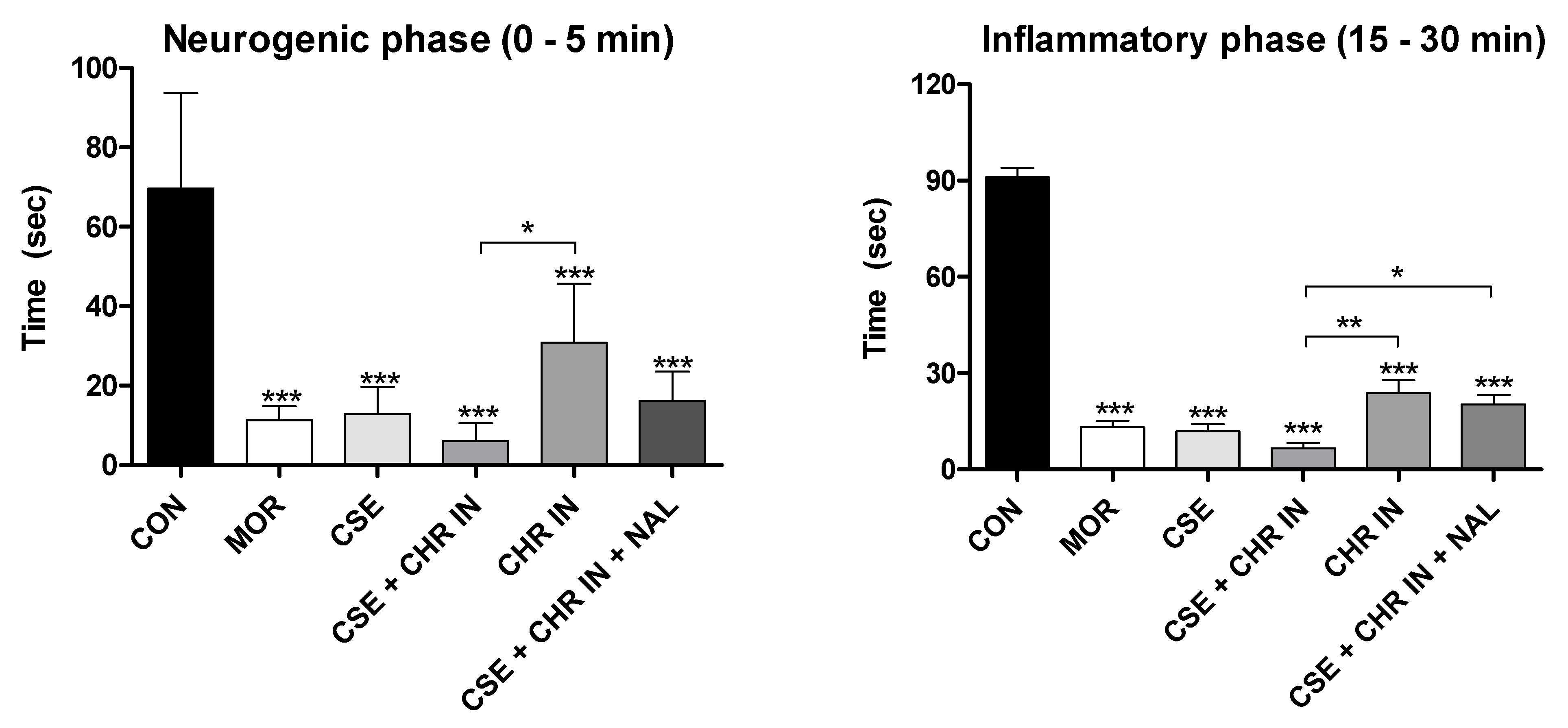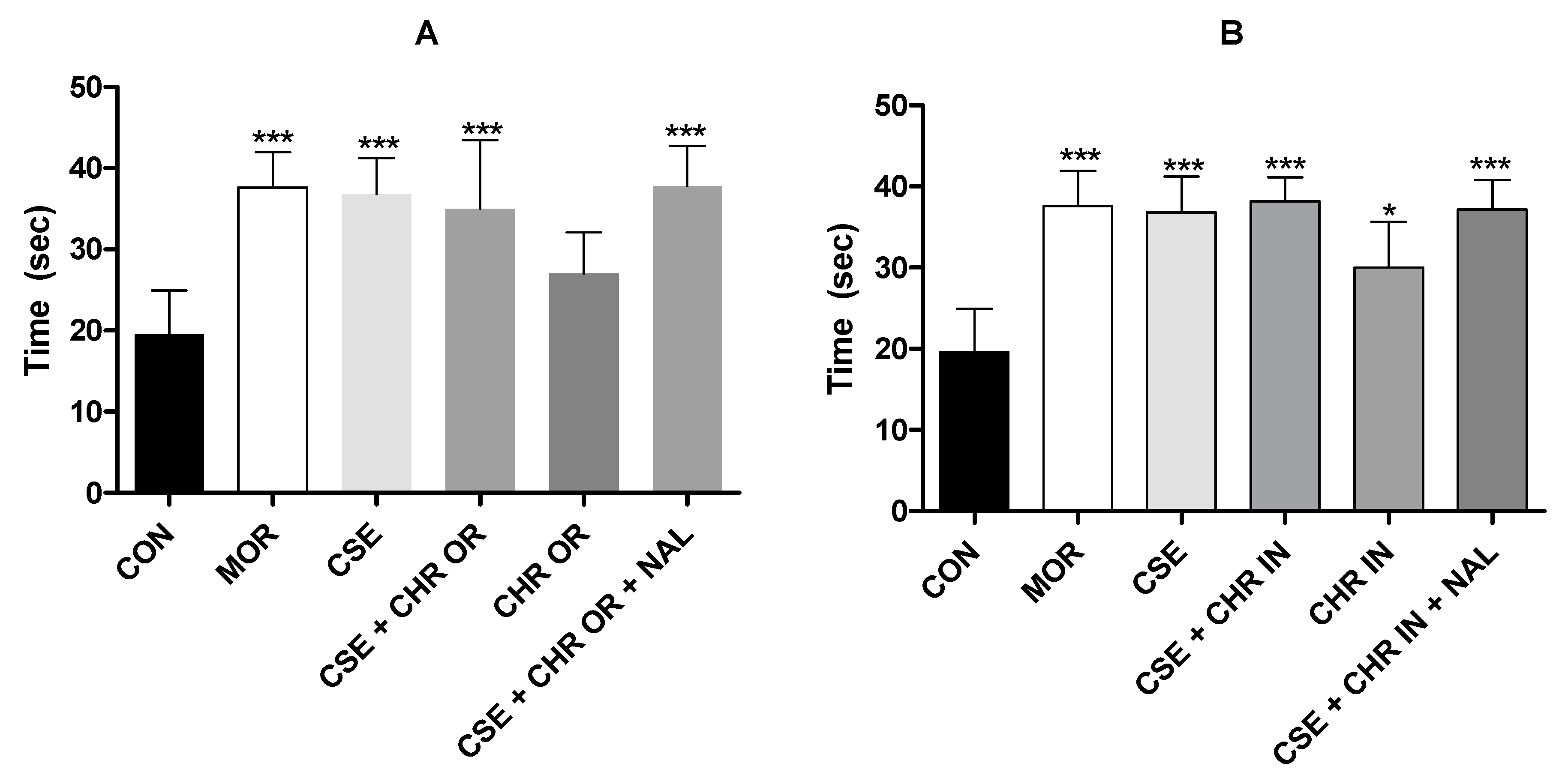Synergistic Pain-Reducing Effects of Bixa orellana (Chronic® and Chronic In®) and Cannabidiol-Rich Cannabis sativa Extracts in Experimental Pain Models
Abstract
:1. Introduction
2. Results and Discussion
2.1. Chemical Analysis of Bixa orellana and Cannabis sativa Oils
2.2. Characterization of Injectable Nanodispersion (Chronic in®) of B. orellana
2.3. Evaluation of Treatments in Pain Models
3. Materials and Methods
3.1. Acquisition of Cannabis sativa Extract and Chemical Analysis by G.C.
3.2. Acquisition of B. orellana Oil and Chemical Analysis
3.3. Obtention of the Granules of Bixa orellana (Chronic®)
3.4. Obtention of Polymeric Nanoparticles Containing Bixa orellana Oil (Chronic in®)
3.5. Characterization of B. orellana Nanosuspension (Chronic in®)
3.6. Study Design and Ethical Considerations
3.7. Animals Used
3.8. Experimental Design
3.9. Formalin Test
3.10. Hot Plate Test
3.11. Cold-Water Tail Withdrawal Test
3.12. Acetic Acid-Induced Abdominal Writhing
3.13. Statistical Analysis
4. Conclusions
5. Patents
Author Contributions
Funding
Institutional Review Board Statement
Informed Consent Statement
Data Availability Statement
Acknowledgments
Conflicts of Interest
References
- Williams, A.C.D.C.; Craig, K.D. Updating the definition of pain. Pain 2016, 157, 2420–2423. [Google Scholar] [CrossRef] [PubMed]
- Raja, S.N.; Carr, D.B.; Cohen, M.; Finnerup, N.B.; Flor, H.; Gibson, S.; Keefe, F.J.; Mogil, J.S.; Ringkamp, M.; Sluka, K.A.; et al. The revised International Association for the Study of Pain definition of pain: Concepts, challenges, and compromises. Pain 2020, 161, 1976–1982. [Google Scholar] [CrossRef] [PubMed]
- Urits, I.; Gress, K.; Charipova, K.; Habib, K.; Lee, D.; Lee, C.; Jung, J.W.; Kassem, H.; Cornett, E.; Paladini, A.; et al. Use of cannabidiol (CBD) for the treatment of chronic pain. Best Pract. Res. Clin. Anaesthesiol. 2020, 34, 463–477. [Google Scholar] [CrossRef] [PubMed]
- Hill, K.P.; Palastro, M.D.; Johnson, B.; Ditre, J.W. Cannabis and Pain: A Clinical Review. Cannabis Cannabinoid Res. 2017, 2, 96–104. [Google Scholar] [CrossRef]
- Batista, M.A.; Santos, A.V.T.d.L.T.d.; Nascimento, A.L.D.; Moreira, L.F.; Souza, I.R.S.; da Silva, H.R.; Pereira, A.C.M.; Hage-Melim, L.I.d.S.; Carvalho, J.C.T. Potential of the Compounds from Bixa orellana Purified Annatto Oil and Its Granules (Chronic®) against Dyslipidemia and Inflammatory Diseases: In Silico Studies with Geranylgeraniol and Tocotrienols. Molecules 2022, 27, 1584. [Google Scholar] [CrossRef]
- Aktary, N.; Sultana, S.; Hossain, M.L. Assessment of analgesic and neuropharmacological activity of leaves of Bixa orellana (Family: Bixaceae). Int. J. Sci. Rep. 2019, 6, 13. [Google Scholar] [CrossRef]
- Shilpi, J.A.; Taufiq-Ur-Rahman, M.; Uddin, S.J.; Alam, M.S.; Sadhu, S.K.; Seidel, V. Preliminary pharmacological screening of Bixa orellana L. leaves. J. Ethnopharmacol. 2006, 108, 264–271. [Google Scholar] [CrossRef]
- Tejpal Singh, H.S.; Aminuddin, A.A.; Pang, K.L.; Ekeuku, S.O.; Chin, K.Y. The Role of Tocotrienol in Arthritis Management—A Scoping Review of Literature. Pharmaceuticals 2023, 16, 385. [Google Scholar] [CrossRef]
- Aggarwal, V.; Kashyap, D.; Sak, K.; Tuli, H.S.; Jain, A.; Chaudhary, A.; Garg, V.K.; Sethi, G.; Yerer, M.B. Molecular mechanisms of action of tocotrienols in cancer: Recent trends and advancements. Int. J. Mol. Sci. 2019, 20, 656. [Google Scholar] [CrossRef]
- Ranasinghe, R.; Mathai, M.; Zulli, A. Revisiting the therapeutic potential of tocotrienol. BioFactors 2022, 48, 813–856. [Google Scholar] [CrossRef]
- Carvalho, H.d.O.; Gonçalves, D.E.S.; Picanço, K.R.T.; Santos, A.V.T.d.L.T.d.; Lucia, M.; Hu, X.; Fernandes, C.P.; Ferreira, I.M.; Carvalho, J.C.T. Actions of Cannabis sativa L. fixed oil and nanoemulsion on venom-induced inflammation of Bothrops moojeni snake in rats. Inflammopharmacology 2021, 29, 123–135. [Google Scholar] [CrossRef] [PubMed]
- Mlost, J.; Bryk, M.; Starowicz, K. Cannabidiol for pain treatment: Focus on pharmacology and mechanism of action. Int. J. Mol. Sci. 2020, 21, 8870. [Google Scholar] [CrossRef] [PubMed]
- Neelakantan, H.; Tallarida, R.J.; Reichenbach, Z.W.; Tuma, R.F.; Ward, S.J.; Walker, E.A. Distinct interactions of cannabidiol and morphine in three nociceptive behavioral models in mice. Behav. Pharmacol. 2015, 26, 304–314. [Google Scholar] [CrossRef] [PubMed]
- Sales, P.F.; Nascimento, A.L.D.; Pinheiro, F.C.; Alberto, A.K.M.; Santos, A.V.T.d.L.T.d.; Carvalho, H.d.O.; de Souza, G.C.; Carvalho, J.C.T. Effect of the Association of Fixed Oils from Abelmoschus esculentus (L.) Moench, Euterpe oleracea Martius, Bixa orellana Linné and Chronic SM® on Atherogenic Dyslipidemia in Wistar Rats. Molecules 2023, 28, 6689. [Google Scholar] [CrossRef]
- Yong, S.T.; Wong, H.; Mohammad, M. Tocotrienol and Tocopherol Contents of Annatto Seed Accessions. J. Sci. Technol. Trop. 2014, 10, 15–25. [Google Scholar]
- de Oliveira Carvalho, H.; Laura, A.; Sauma, R.; Emanuelle, D.; Gonçalves, S.; Gomes, L.; Ribeiro Da Silva, H.; César, A.; Pereira, M.; Carlos, J.; et al. Intramuscular compatibility of an injectable nanodispersion anti-inflammatory (Chronic®) from a standardized Bixa orellana oil: A toxicological study in Wistar rats. arXiv 2022. [Google Scholar] [CrossRef]
- Mitchell, M.J.; Billingsley, M.M.; Haley, R.M.; Wechsler, M.E.; Peppas, N.A.; Langer, R. Engineering precision nanoparticles for drug delivery. Nat. Rev. Drug Discov. 2021, 20, 101–124. [Google Scholar] [CrossRef]
- Pereira, T.A.; Guerreiro, C.M.; Maruno, M.; Ferrari, M.; Rocha-Filho, P.A. Exotic vegetable oils for cosmetic o/w nanoemulsions: In vivo evaluation. Molecules 2016, 21, 248. [Google Scholar] [CrossRef]
- Gumiero, V.C.; Rocha-Filho, P.A. Babassu nanoemulsions have physical and chemical stability. J. Disp. Sci. Technol. 2012, 33, 1569–1573. [Google Scholar] [CrossRef]
- Oca-Ávalos, J.M.M.; Candal, R.J.; Herrera, M.L. Nanoemulsions: Stability and physical properties. Curr. Opin. Food Sci. 2017, 16, 1–6. [Google Scholar] [CrossRef]
- Zielińska, A.; Carreiró, F.; Oliveira, A.M.; Neves, A.; Pires, B.; Venkatesh, D.N.; Durazzo, A.; Lucarini, M.; Eder, P.; Silva, A.M.; et al. Polymeric Nanoparticles: Production, Characterization, Toxicology and Ecotoxicology. Molecules 2020, 25, 3731. [Google Scholar] [CrossRef] [PubMed]
- Bunman, S.; Muengtaweepongsa, S.; Piyayotai, D.; Charlermroj, R.; Phuengwas, S.; Makornwattana, M. Study the Effect of Cannabidiol Topical on Antinociceptive and Anti-inflammatory Activities in Animal Model. arXiv 2022. [Google Scholar] [CrossRef]
- Foss, J.D.; Farkas, D.J.; Huynh, L.M.; Kinney, W.A.; Brenneman, D.E.; Ward, S.J. Behavioural and pharmacological effects of cannabidiol (CBD) and the cannabidiol analogue KLS-13019 in mouse models of pain and reinforcement. Br. J. Pharmacol. 2021, 178, 3067–3078. [Google Scholar] [CrossRef] [PubMed]
- Silva, J.C.; Oliveira-Júnior, R.G.; Silva, M.G.; Lavor, E.M.; Soares, J.M.D.; Lima-Saraiva, S.R.G.; Diniz, T.C.; Medeiros, M.A.M.B.; Lima, L.M.; Barreiro, E.J.; et al. In Mice Evaluation of Antinociceptive and Anti-inflammatory Activity of N-acylhydrazone Derivative LASSBio-1587. Rev. Virtual Quim. 2021, 13, 1467–1472. [Google Scholar] [CrossRef]
- Menezes, P.M.N.; Araújo, T.C.d.L.; Pereira, E.C.V.; Neto, J.A.; Silva, D.S.; Brito, M.C.; Lima, K.S.B.; Monte, A.P.O.D.; de Matos, M.H.T.; de Lima, R.S.; et al. Investigation of antinociceptive, antipyretic, antiasthmatic, and spasmolytic activities of Brazilian Cannabis sativa L. roots in rodents. J. Ethnopharmacol. 2021, 278, 114259. [Google Scholar] [CrossRef]
- Batista, E.; Trindade, H.; Lira, S.; Muller, J.; Silva, L.; Batista, M. Atividades antinociceptiva e antiinflamatória do extrato etanólico de Luehea divaricata. Rev. Bras. Plantas Med. 2016, 18, 433–441. [Google Scholar] [CrossRef]
- Tjølsen, A.; Berge, O.-G.; Hunskaar, S.; Rosland, J.H.; Hole, K. The formalin test: An evaluation of the method. Pain 1992, 51, 5–17. [Google Scholar] [CrossRef]
- Bannon, A.W.; Malmberg, A.B. Models of nociception: Hot-plate, tail-flick, and formalin tests in rodents. Curr. Protocols Nucleic Acid Chem. 2007, 41, 8–9. [Google Scholar] [CrossRef]
- Razavi, Y.; Rashvand, M.; Sharifi, A.; Haghparast, A.; Keyhanfar, F.; Haghparast, A. Cannabidiol microinjection into the nucleus accumbens attenuated nociceptive behaviors in an animal model of tonic pain. Neurosci. Lett. 2021, 762, 136141. [Google Scholar] [CrossRef]
- Costa, B.; Colleoni, M.; Conti, S.; Parolaro, D.; Franke, C.; Trovato, A.E.; Giagnoni, G. Oral anti-inflammatory activity of cannabidiol, a non-psychoactive constituent of cannabis, in acute carrageenan-induced inflammation in the rat paw. Naunyn-Schmiedeberg's Arch. Pharmacol. 2004, 369, 294–299. [Google Scholar] [CrossRef] [PubMed]
- Atalay, S.; Jarocka-karpowicz, I.; Skrzydlewskas, E. Antioxidative and anti-inflammatory properties of cannabidiol. Antioxidants 2020, 9, 21. [Google Scholar] [CrossRef] [PubMed]
- Sofia, R.D.; Vassar, H.B.; Knobloch, L.C. Comparative Analgesic Activity of Various Naturally Occurring Cannabinoids in Mice and Rats. Psychopharmacologia 1975, 40, 285–295. [Google Scholar] [CrossRef] [PubMed]
- Nascimento, G.C.D.; Ferrari, D.P.; Guimaraes, F.S.; Del Bel, E.A.; Bortolanza, M.; Junior, N.C.F. Cannabidiol increases the nociceptive threshold in a preclinical model of Parkinson’s disease. Neuropharmacology 2020, 163, 107808. [Google Scholar] [CrossRef] [PubMed]
- Adams, J.U.; Geller, E.B.; Adler, M.W. Receptor selectivity of icv morphine in the rat cold water tail-flick test. Drug Alcohol Depend. 1994, 35, 197–202. [Google Scholar] [CrossRef] [PubMed]
- Pizziketti, R.J.; Pressman, N.S.; Geller, E.B.; Cowan, A.; Adler, M.W.; Pizziketti, R.J. 23 Elsevier rat cold water tall-flick: A novel analgesic test that distinguishes opioid agonists from mixed agonist-antagonists. Eur. J. Pharmacol. 1985, 119, 23–29. [Google Scholar] [CrossRef] [PubMed]
- Moore, C.F.; Weerts, E.M. Cannabinoid tetrad effects of oral Δ9-tetrahydrocannabinol (THC) and cannabidiol (CBD) in male and female rats: Sex, dose-effects and time course evaluations. Psychopharmacology 2022, 239, 1397–1408. [Google Scholar] [CrossRef] [PubMed]
- Sadaka, A.H.; Canuel, J.; Febo, M.; Johnson, C.T.; Bradshaw, H.B.; Ortiz, R.; Ciumo, F.; Kulkarni, P.; Gitcho, M.A.; Ferris, C.F. Effects of inhaled cannabis high in Δ9-THC or CBD on the aging brain: A translational MRI and behavioral study. Front. Aging Neurosci. 2023, 15, 1055433. [Google Scholar] [CrossRef]
- Rodrigues, A.P.S.; Barbosa, R.d.S.; Pereira, A.C.M.; Batista, M.A.; Sales, P.F.; Ferreira, A.M.; Colares, N.N.D.; da Silva, H.R.; Soares, M.O.d.S.; Hage-Melim, L.I.d.S.; et al. Ormona® SI and Ormona® RC—New Nutraceuticals with Geranylgeraniol, Tocotrienols, Anthocyanins, and Isoflavones—Decrease High-Fat Diet-Induced Dyslipidemia in Wistar Rats. Nutraceuticals 2022, 2, 311–322. [Google Scholar] [CrossRef]
- Borges, R.S.; Lima, E.S.; Keita, H.; Ferreira, I.M.; Fernandes, C.P.; Cruz, R.A.S.; Duarte, J.L.; Velázquez-Moyado, J.; Ortiz, B.L.S.; Castro, A.N.; et al. Anti-inflammatory and antialgic actions of a nanoemulsion of Rosmarinus officinalis L. essential oil and a molecular docking study of its major chemical constituents. Inflammopharmacology 2018, 26, 183–195. [Google Scholar] [CrossRef]
- Dubuisson, D.; Dennis, S.G. the formalin test: A quantitative study of the analgesic effects of morphine, meperidine, and brain stem stimulation in rats and cats. Pain 1977, 4, 161–174. [Google Scholar] [CrossRef]
- İnaltekin, A.; Kivrak, Y. Evaluation of the effect of vortioxetine on pain threshold by hot-plate test in mice. Noro Psikiyatr. Arsivi 2021, 58, 274–277. [Google Scholar] [CrossRef] [PubMed]
- Sharma, S.S.; Kumar, A.; Kaundal, R.K. Protective effects of 4-amino1,8-napthalimide, a poly (ADP-ribose) polymerase inhibitor in experimental diabetic neuropathy. Life Sci. 2008, 82, 570–576. [Google Scholar] [CrossRef] [PubMed]
- Collier, J.; Dinneen, L.C.; Johnson, C.A.; Schneider, C. The abdominal constriction response and its suppression by analgesic drugs in the mouse. Br. J. Pharmacol. 1968, 32, 295–310. [Google Scholar] [CrossRef] [PubMed]






| P. Zeta (mV) | Size (nm) | PDI | pH | |
|---|---|---|---|---|
| Day 1 | 19.86 ± 0.60 | 53.15 ± 0.64 | 0.533 ± 0.008 | 5.8 ± 0.01 |
| Day 30 | 19.66 ± 1.45 | 59.90 ± 3.63 | 0.594 ± 0.014 | 5.8 ± 0.01 |
Disclaimer/Publisher’s Note: The statements, opinions and data contained in all publications are solely those of the individual author(s) and contributor(s) and not of MDPI and/or the editor(s). MDPI and/or the editor(s) disclaim responsibility for any injury to people or property resulting from any ideas, methods, instructions or products referred to in the content. |
© 2024 by the authors. Licensee MDPI, Basel, Switzerland. This article is an open access article distributed under the terms and conditions of the Creative Commons Attribution (CC BY) license (https://creativecommons.org/licenses/by/4.0/).
Share and Cite
Santos, A.d.M.; Carvalho, H.d.O.; Gonçalves, D.E.S.; Gomes, L.P.; Colares, N.N.D.; dos Santos, A.V.T.d.L.T.; dos Santos, A.Y.S.; Teixeira, T.A.; Carvalho, J.C.T. Synergistic Pain-Reducing Effects of Bixa orellana (Chronic® and Chronic In®) and Cannabidiol-Rich Cannabis sativa Extracts in Experimental Pain Models. Pharmaceuticals 2024, 17, 1710. https://doi.org/10.3390/ph17121710
Santos AdM, Carvalho HdO, Gonçalves DES, Gomes LP, Colares NND, dos Santos AVTdLT, dos Santos AYS, Teixeira TA, Carvalho JCT. Synergistic Pain-Reducing Effects of Bixa orellana (Chronic® and Chronic In®) and Cannabidiol-Rich Cannabis sativa Extracts in Experimental Pain Models. Pharmaceuticals. 2024; 17(12):1710. https://doi.org/10.3390/ph17121710
Chicago/Turabian StyleSantos, Alicia de Melo, Helison de Oliveira Carvalho, Danna Emanuelle Santos Gonçalves, Luciana Paes Gomes, Nayara Nilcia Dias Colares, Abrahão Victor Tavares de Lima Teixeira dos Santos, Adrielly Yasmin Sousa dos Santos, Thiago Afonso Teixeira, and José Carlos Tavares Carvalho. 2024. "Synergistic Pain-Reducing Effects of Bixa orellana (Chronic® and Chronic In®) and Cannabidiol-Rich Cannabis sativa Extracts in Experimental Pain Models" Pharmaceuticals 17, no. 12: 1710. https://doi.org/10.3390/ph17121710
APA StyleSantos, A. d. M., Carvalho, H. d. O., Gonçalves, D. E. S., Gomes, L. P., Colares, N. N. D., dos Santos, A. V. T. d. L. T., dos Santos, A. Y. S., Teixeira, T. A., & Carvalho, J. C. T. (2024). Synergistic Pain-Reducing Effects of Bixa orellana (Chronic® and Chronic In®) and Cannabidiol-Rich Cannabis sativa Extracts in Experimental Pain Models. Pharmaceuticals, 17(12), 1710. https://doi.org/10.3390/ph17121710






